Influence of the Variable Cross-Section Stator Ventilation Structure on the Temperature of an Induction Motor
Abstract
:1. Introduction
2. Motor Model
2.1. Hydrodynamic Model
2.2. Motor Heat Transfer Model
2.3. Physical Model and Pretreatment
2.4. Basic Assumptions and Boundary Conditions
- The influence of buoyancy and gravity on the fluid flow is ignored.
- Given that the fluid flow is slower than sound, the fluid is treated as an incompressible fluid.
- It is assumed that the heat is evenly distributed in the components of the motor.
- The entrance boundary is defined as the velocity entrance with its velocity at 25.5 m/s.
- The outlet boundary is defined as the pressure outlet with the initial pressure at 1 atmosphere.
- The solid surfaces in contact with air are set as non-slip boundary conditions.
2.5. Calculation of Motor Heat
3. Simulation and Analysis of Original Ventilation Model
4. Analysis of Motor Temperature Field and Fluid Field under Different Stator Ventilation Structures
4.1. Analysis of the Nonlinear Variable Cross-Section Stator Ventilation Structure
4.2. Analysis of the Linear Variable Cross-Section Stator Ventilation Structure
4.3. Analysis of Stator Ventilation Structure with Varying Cross-Sectional Diameter
4.4. Analysis of Stator Ventilation Structure with Varying Radial Position
5. Conclusions
- (1)
- The cooling effect of the nonlinear variable cross-section cylindrical stator ventilation structure is more effective than that of the original ventilation structure, and with an increase in the number of segments, the temperature of each part of the motor shows a downward trend.
- (2)
- Under the same cross-sectional diameter, the cooling effect of the linear variable cross-section ventilation hole shows a small difference compared to that of the nonlinear variable cross-section ventilation hole. However, making a linear variable cross-section hole is technically challenging and the cost is also very high, while the nonlinear variable cross-section hole can be realized through stator core splicing, so the nonlinear cross-section ventilation hole is more desirable.
- (3)
- As the cross-sectional diameter of the stator ventilation hole decreases, the temperature of each part of the motor drops significantly. However, when the diameter is reduced to a certain value, the increasing trend of the wind velocity in the stator ventilation hole slows down, and the temperature of the stator changes only slightly. If the diameter is continuously reduced, the wind velocity in the rotor ventilation hole will increase, and the temperature of the rotor will continue to decrease.
- (4)
- The maximum temperature appears on the side of the air outlet, and it is greatly affected by the circulation wind speed and the circulation radius at the end. When the ventilation holes are close to the winding, the air from the stator ventilation holes can directly cool the end of the winding, which has a better dissipation effect.
- (5)
- By gradually attempting to identify a better scheme, the optimal stator ventilation structure is obtained. Compared to the original ventilation model, the maximum temperatures of the stator winding, stator core, rotor bar, rotor core, and slot insulation are reduced by 17.13 °C, 14.56 °C, 46.53 °C, 43.81 °C, and 16.56 °C, respectively. The cooling effect is obvious, and the heat dissipation capacity of the motor is significantly enhanced.
Author Contributions
Funding
Institutional Review Board Statement
Informed Consent Statement
Data Availability Statement
Conflicts of Interest
References
- Cao, J.; Li, W.; Zhang, Y.; Zhang, X.; Jiang, Y.; He, Y. Analyses on heat transfer and fluid flowing in a traction motor used in high-speed CRH. In Proceedings of the 2015 International Conference on Electrical Systems for Aircraft, Railway, Ship Propulsion and Road Vehicles (ESARS), Aachen, Germany, 3–5 March 2015; pp. 1–8. [Google Scholar]
- Chen, J.; Ma, J.; Fang, Y.; Li, T.; Li, J. Analysis of temperature field distribution of magnetic-fluid bearing for high-speed trains. In Proceedings of the 2015 18th International Conference on Electrical Machines and Systems (ICEMS), Pattaya, Thailand, 25–28 October 2015; pp. 620–623. [Google Scholar]
- Ding, S.; Li, H. Investigation of characteristics of fluid flow pattern for air-cooled motor. In Proceedings of the 2016 IEEE 11th Conference on Industrial Electronics and Applications (ICIEA), Hefei, China, 5–7 June 2016; pp. 2044–2048. [Google Scholar]
- Huang, Z.; Fang, J.; Liu, X.; Han, B. Loss calculation and thermal analysis of rotors supported by active magnetic bearings for high-speed permanent-magnet electrical machines. IEEE Trans. Ind. Electron. 2015, 63, 2027–2035. [Google Scholar] [CrossRef]
- Chu, S.; Liang, D.; Jia, S.; Liang, Y. Research and Analysis on Design Characteristics of High Temperature and High-Speed Permanent Magnet Motor. In Proceedings of the 2020 International Conference on Electrical Machines (ICEM), Gothenburg, Sweden, 23–26 August 2020; Volume 1, pp. 2452–2456. [Google Scholar]
- Gai, Y.; Kimiabeigi, M.; Chong, Y.; Widmer, J.; Deng, X.; Popescu, M.; Steven, A. Cooling of automotive traction motors: Schemes, examples, and computation methods. IEEE Trans. Ind. Electron. 2018, 66, 1681–1692. [Google Scholar] [CrossRef] [Green Version]
- Bourgault, A.; Roy, P.; Ghosh, E.; Kar, N. A Survey of Different Cooling Methods for Traction Motor Application. In Proceedings of the 2019 IEEE Canadian Conference of Electrical and Computer Engineering (CCECE), Edmonton, AB, Canada, 5–8 May 2019; pp. 1–4. [Google Scholar]
- Huang, Z.; Nategh, S.; Lassila, V.; Alaküla, M.; Yuan, J. Direct oil cooling of traction motors in hybrid drives. In Proceedings of the 2012 IEEE International Electric Vehicle Conference, Greenville, SC, USA, 4–8 March 2012; pp. 1–8. [Google Scholar]
- Zhang, Y.; Ruan, J.; Huang, T.; Yang, X.; Zhu, H.; Yang, G. Calculation of temperature rise in air-cooled induction motors through 3-D coupled electromagnetic fluid-dynamical and thermal finite-element analysis. IEEE Trans. Magn. 2012, 48, 1047–1050. [Google Scholar] [CrossRef]
- Chen, Y.; Chen, W.; Zhou, J.; Fang, Y.; Yao, Y. Multi-field coupled analysis of a permanent magnet synchronous motor: Application to high speed rail traction. In Proceedings of the 2016 Eleventh International Conference on Ecological Vehicles and Renewable Energies (EVER), Monte Carlo, Monaco, 6–8 April 2016; pp. 1–6. [Google Scholar]
- Wang, X.; Gao, W. Research on cooling and improved designing of inverter-asynchronous motor compositive system. In Proceedings of the 2011 International Conference on Electrical Machines and Systems, Beijing, China, 20–23 August 2011; pp. 1–6. [Google Scholar]
- Yang, K.; Feng, Y. Design of novel spiral magnetic poles and axial-cooling structure of outer-rotor PM torque motor. IEEE Trans. Appl. Supercond. 2010, 20, 838–841. [Google Scholar] [CrossRef]
- Zhang, Y.; Sun, M.; Ruan, J.; Huang, T. Ventilation Structure Improvement of Large Motors Using 3-D Multi-Physical Coupled-Field Finite-Element Analysis. In Proceedings of the 2012 Sixth International Conference on Electromagnetic Field Problems and Applications, Dalian, China, 19–21 June 2012; pp. 1–4. [Google Scholar]
- Kim, S.C.; Kim, W.; Kim, M.S. Cooling performance of 25 kW in-wheel motor for electric vehicles. Int. J. Automot. Technol. 2013, 14, 559–567. [Google Scholar] [CrossRef]
- Cao, J.; Wu, Z.; Li, W.; Li, D.; Zhang, X.; Zhang, Y.; Huang, J. Influence of axial ventilation structures on electromagnetic field and heat transfer of traction motor used for high—Speed EMU. In Proceedings of the 2017 20th International Conference on Electrical Machines and Systems (ICEMS), Sydney, NSW, Australia, 11–14 August 2017; pp. 1–6. [Google Scholar]
- Li, W.; Li, J.; Li, D. Influence of variable section rotor ventilation ducts on temperature and fluid fields of a full air-cooled large hydro-generator rotor. Trans. China Electrotech. Soc. 2017, 32, 42–48. [Google Scholar]
- Tong, W.; Wu, S.; Tang, R. Totally enclosed self-circulation axial ventilation system design and thermal analysis of a 1.65-MW direct-drive PMSM. IEEE Trans. Ind. Electron. 2018, 65, 9388–9398. [Google Scholar] [CrossRef]
- Cao, Z.; Li, W.; Zhang, X.; Fan, Y.; Zeng, J. Influence of single/dual ventilation path on fluid field and temperature field of HVLSSR-PMSM with air-cooled hybrid ventilation systems. Energies 2018, 11, 1343. [Google Scholar] [CrossRef] [Green Version]
- Zhu, G.; Liu, X.; Li, L.; Chen, H.; Tong, W.; Zhu, J. Cooling system design of a high-speed PMSM based on a coupled fluidic-thermal model. IEEE Trans. Appl. Supercond. 2019, 29, 1–5. [Google Scholar] [CrossRef]
- Liu, W.; Li, W.; Luo, S.; Huang, X.; Li, D.; Li, Z.; Xu, G. Influence of a Novel Stator Teeth Internal Ventilation Structure on Air-Cooled Turbo-Generator Parameters and Stator Temperature. IEEE Access 2020, 8, 122422–122433. [Google Scholar] [CrossRef]
- Li, R.; Cheng, P.; Lan, H.; Li, W.; Gerada, D.; Hong, Y. Stator Non-Uniform Radial Ventilation Design Methodology for a 15 MW Turbo-Synchronous Generator Based on Single Ventilation Duct Subsystem. Energies 2021, 14, 2760. [Google Scholar] [CrossRef]
- Chen, Y.; Zhou, J.; Fang, Y.; Gao, Y.; Xia, Y. Multi-field coupling finite-element analysis of the temperature rise in permanent magnet synchronous motor applied for high speed train. In Proceedings of the 2016 19th International Conference on Electrical Machines and Systems (ICEMS), Chiba, Japan, 13–16 November 2016; pp. 1–4. [Google Scholar]
- Ding, S.; Li, S. Research of heat transfer characteristic for PMSM with two-way ventilation structure. In Proceedings of the 2016 IEEE 11th Conference on Industrial Electronics and Applications (ICIEA), Hefei, China, 5–7 June 2016; pp. 2206–2210. [Google Scholar]
- Li, D.; Wen, Y.; Li, W.; Feng, B.; Cao, J. Three-dimensional temperature field calculation and analysis of an axial-radial flux-type permanent magnet synchronous motor. Energies 2018, 11, 1208. [Google Scholar] [CrossRef] [Green Version]
- Li, W.; Cao, Z.; Zhang, X. Thermal Analysis of the Solid-Rotor Permanent Magnet Synchronous Motors with Air-cooled Hybrid Ventilation Systems. IEEE Trans. Ind. Electron. 2021. [Google Scholar] [CrossRef]
- Schrittwieser, M.; Biro, O.; Farnleitner, E.; Kastner, G. Characterizing the convective heat transfer on stator ventilation ducts for large hydro generators with a neural network. COMPEL Int. J. Comput. Math. Electr. Electron. Eng. 2015, 34, 1522–1536. [Google Scholar] [CrossRef]
- Guo, H.; Ding, Q.; Song, Y.; Tang, H.; Wang, L.; Zhao, J. Predicting temperature of permanent magnet synchronous motor based on deep neural network. Energies 2020, 13, 4782. [Google Scholar] [CrossRef]
- Versteeg, H.K.; Malalasekera, W. An Introduction to Computational Fluid Dynamics: The Finite Volume Method; Pearson Education: London, UK, 2007. [Google Scholar]
- Ding, X.; Liu, B. Fluent 17.0 Fluid Simulation Calculation from Elementary to Proficient; Tsinghua University Press: Beijing, China, 2014. [Google Scholar]
- Tao, L.; Zhang, Y.; Liang, Y.; Qiang, A.; Haishi, D. Thermal Analysis of the Yokeless and Segmented Armature Axial Flux In-wheel Motor. In Proceedings of the 2020 International Conference on Artificial Intelligence and Computer Engineering (ICAICE), Beijing, China, 23–25 October 2020; pp. 449–452. [Google Scholar]
- Fu, X. Electromagnetic Field Computation and Operating Characteristic Analysis for a Permanent Magnet-Inductor Hybrid Excitation Generator. Ph.D. Thesis, Harbin Institute of Technology, Harbin, China, 2011. [Google Scholar]
- Tai, Y.; Liu, Z. Analysis on three-dimensional transient temperature field of induction motor. Proc. CSEE 2010, 30, 114–120. [Google Scholar]


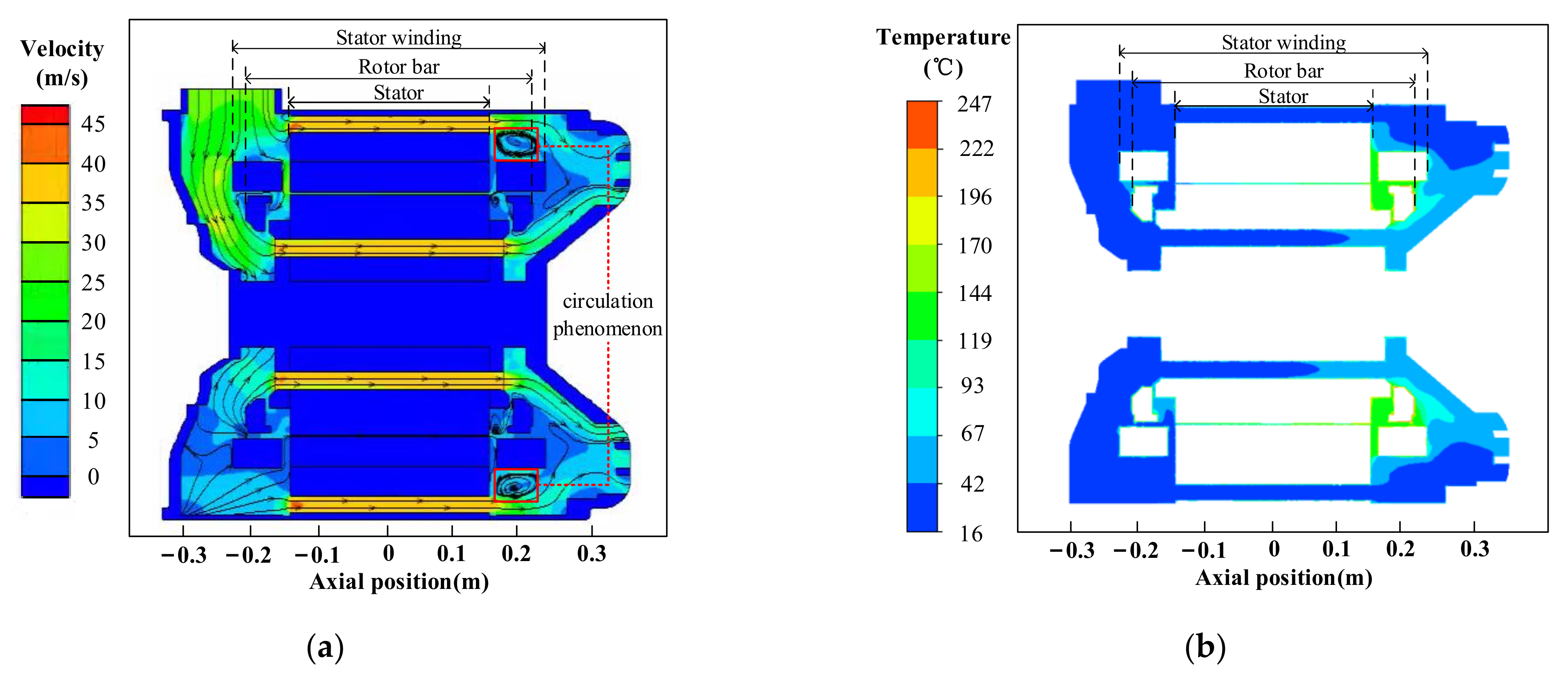

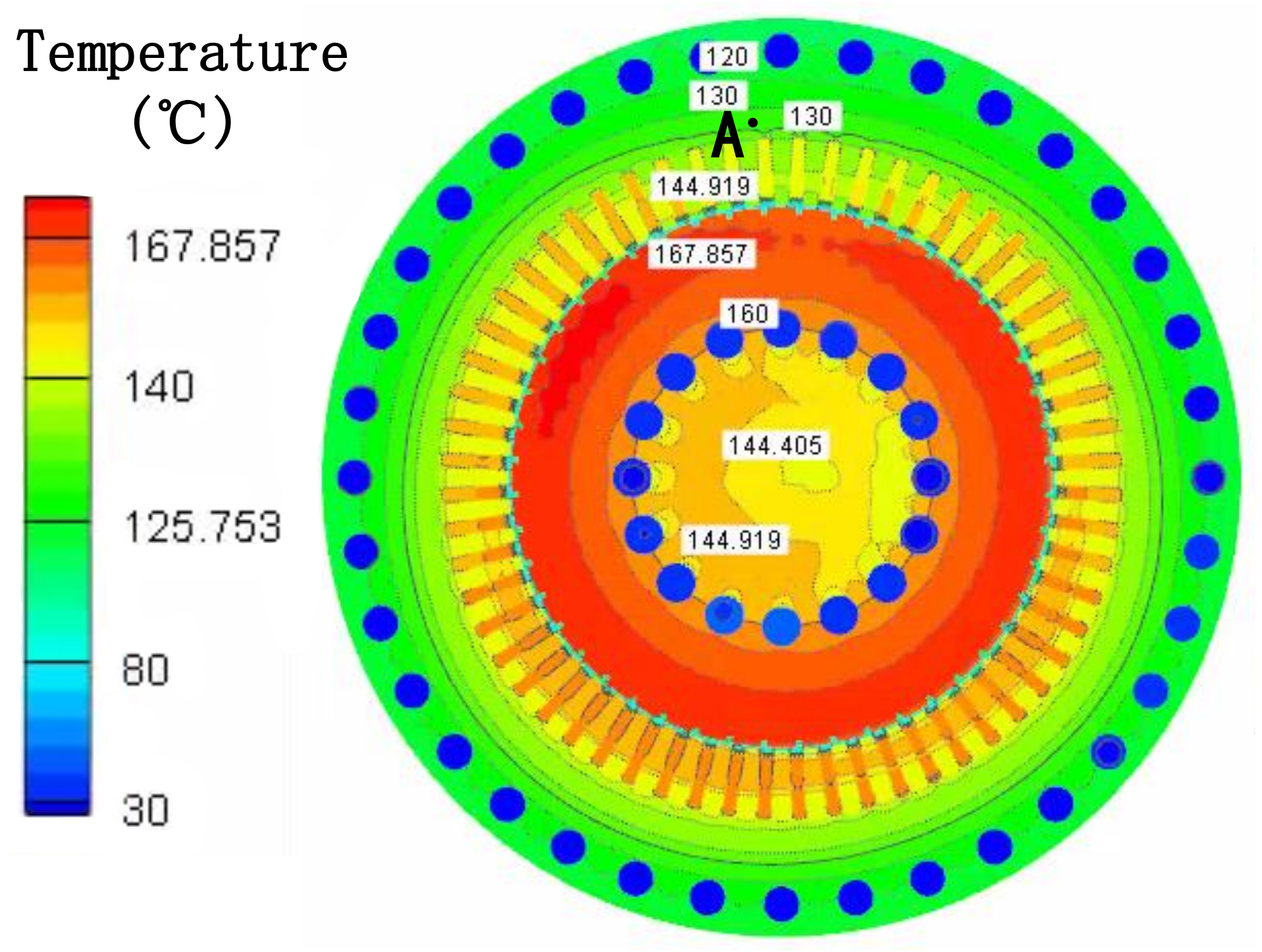


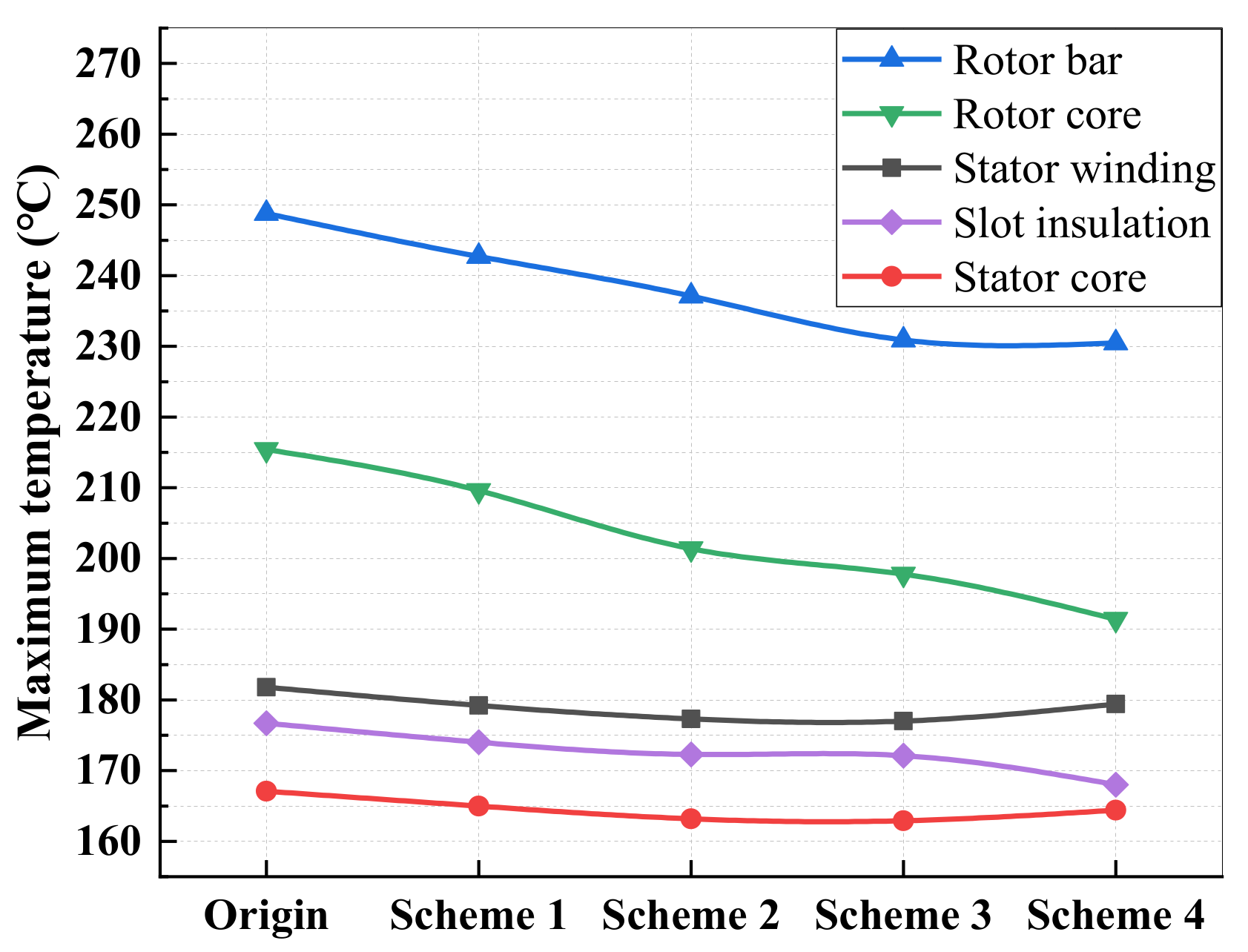
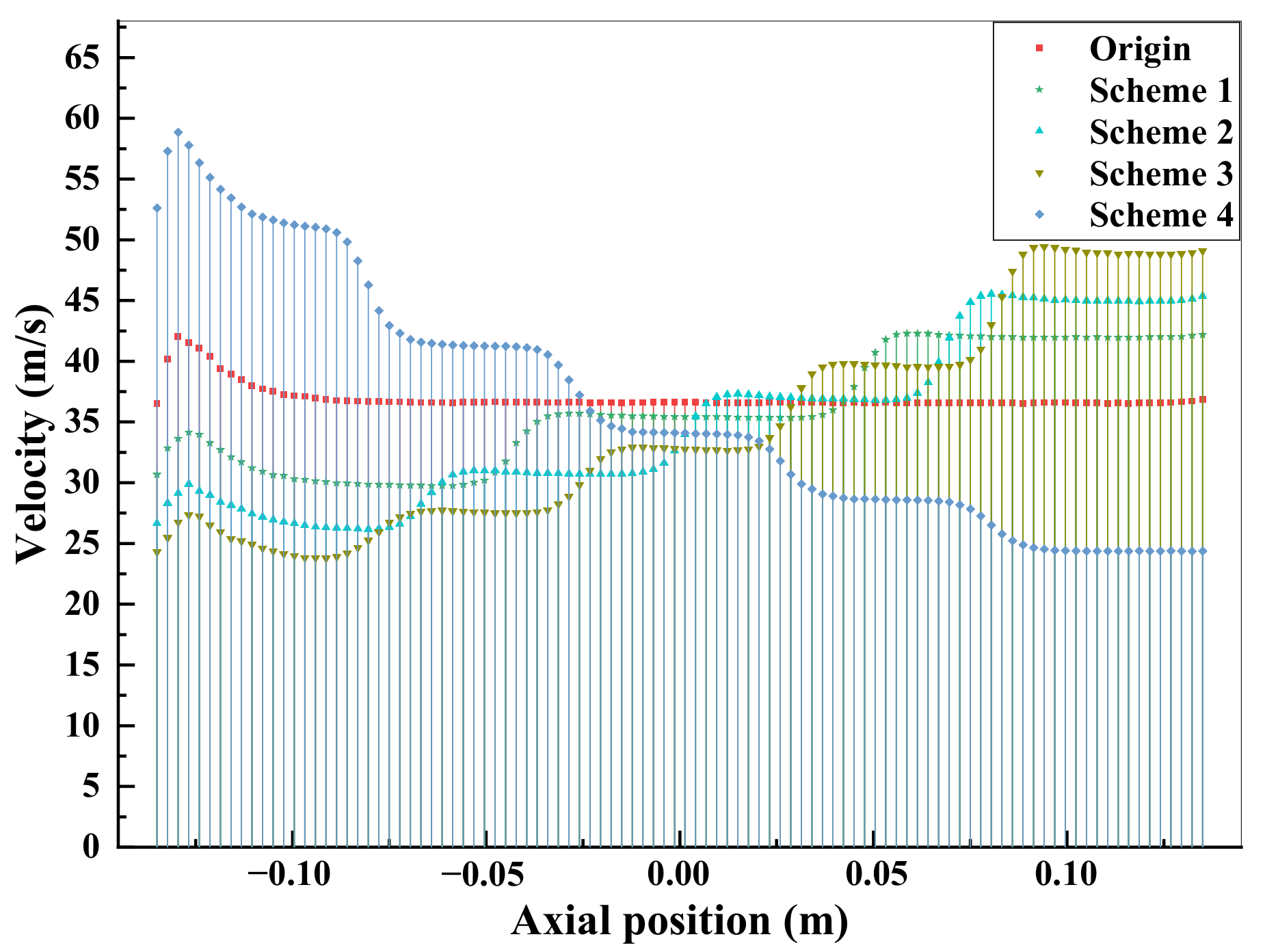

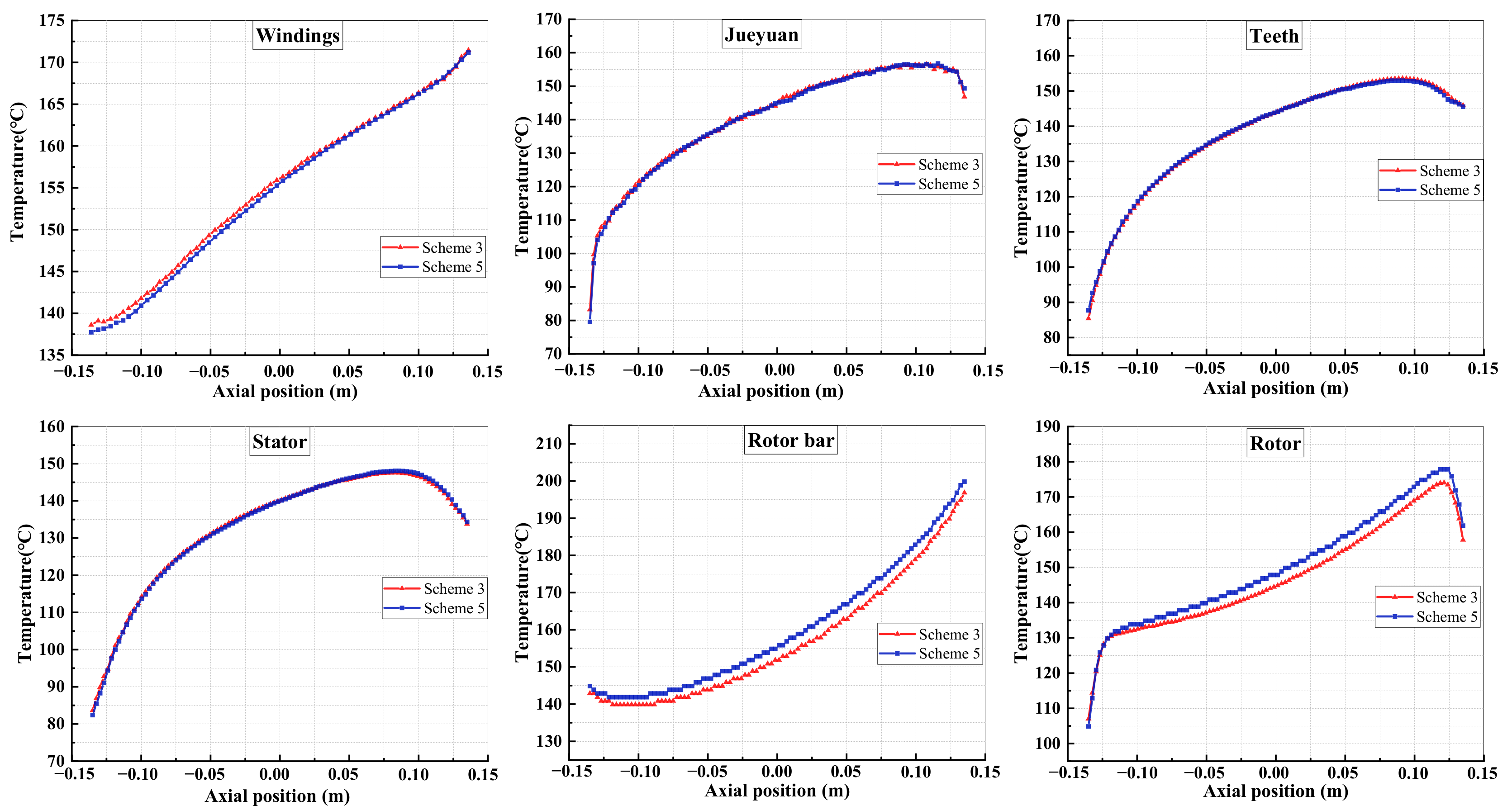

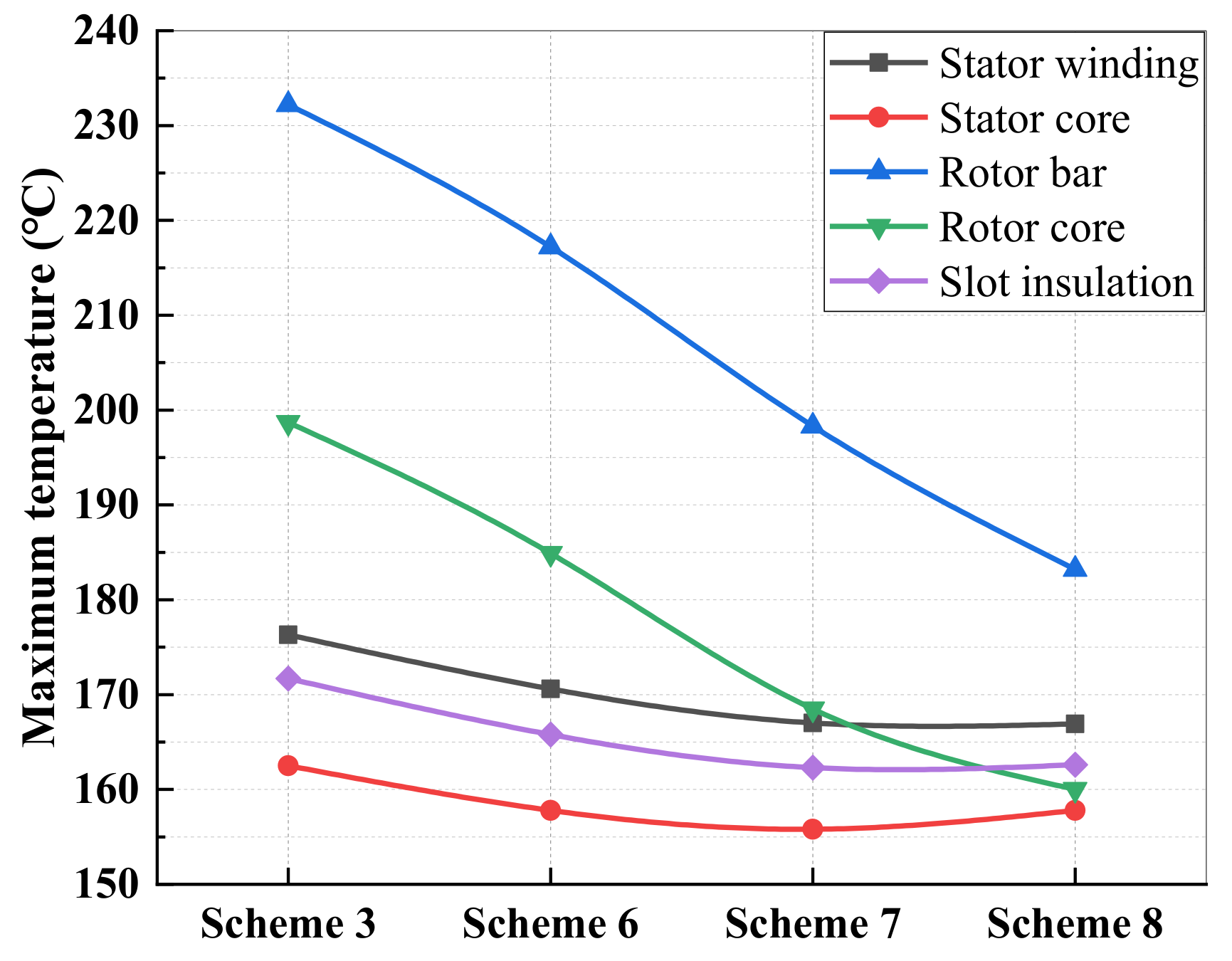
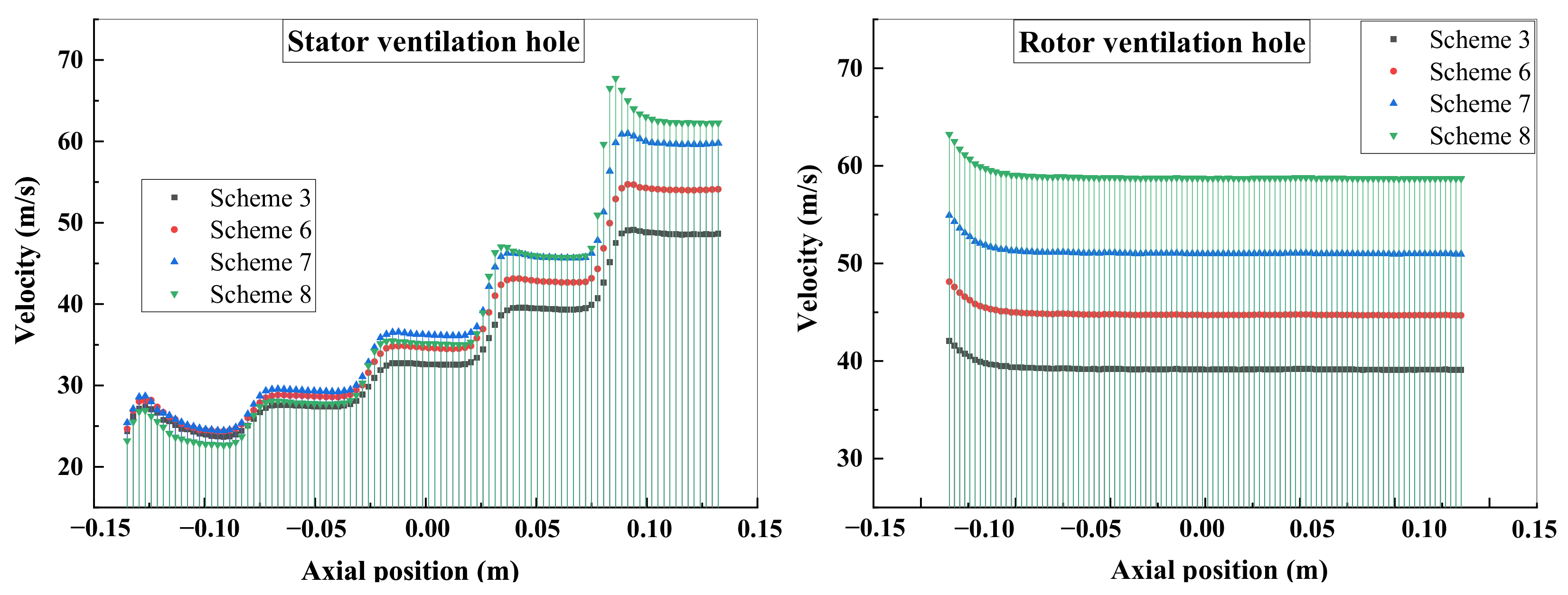

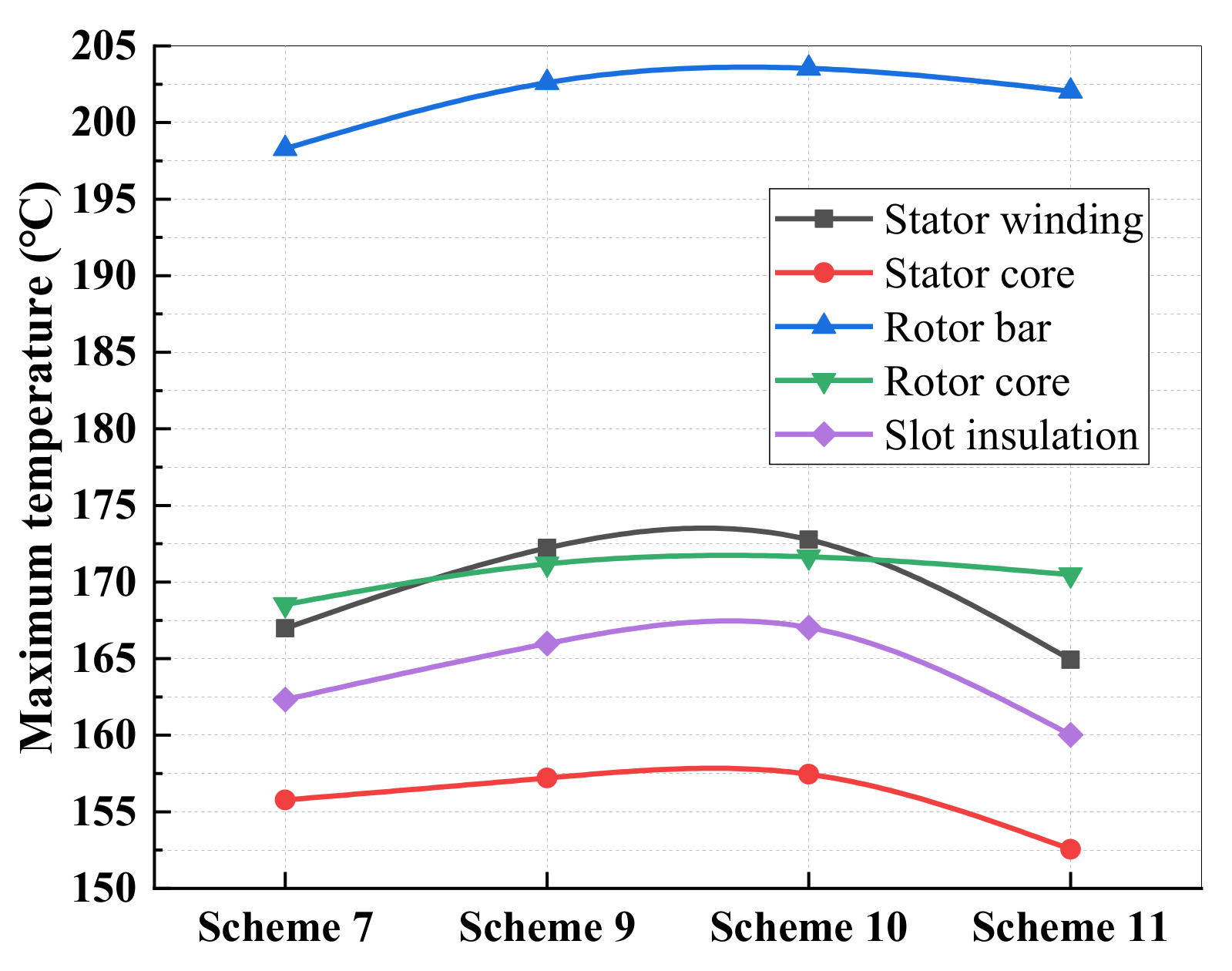
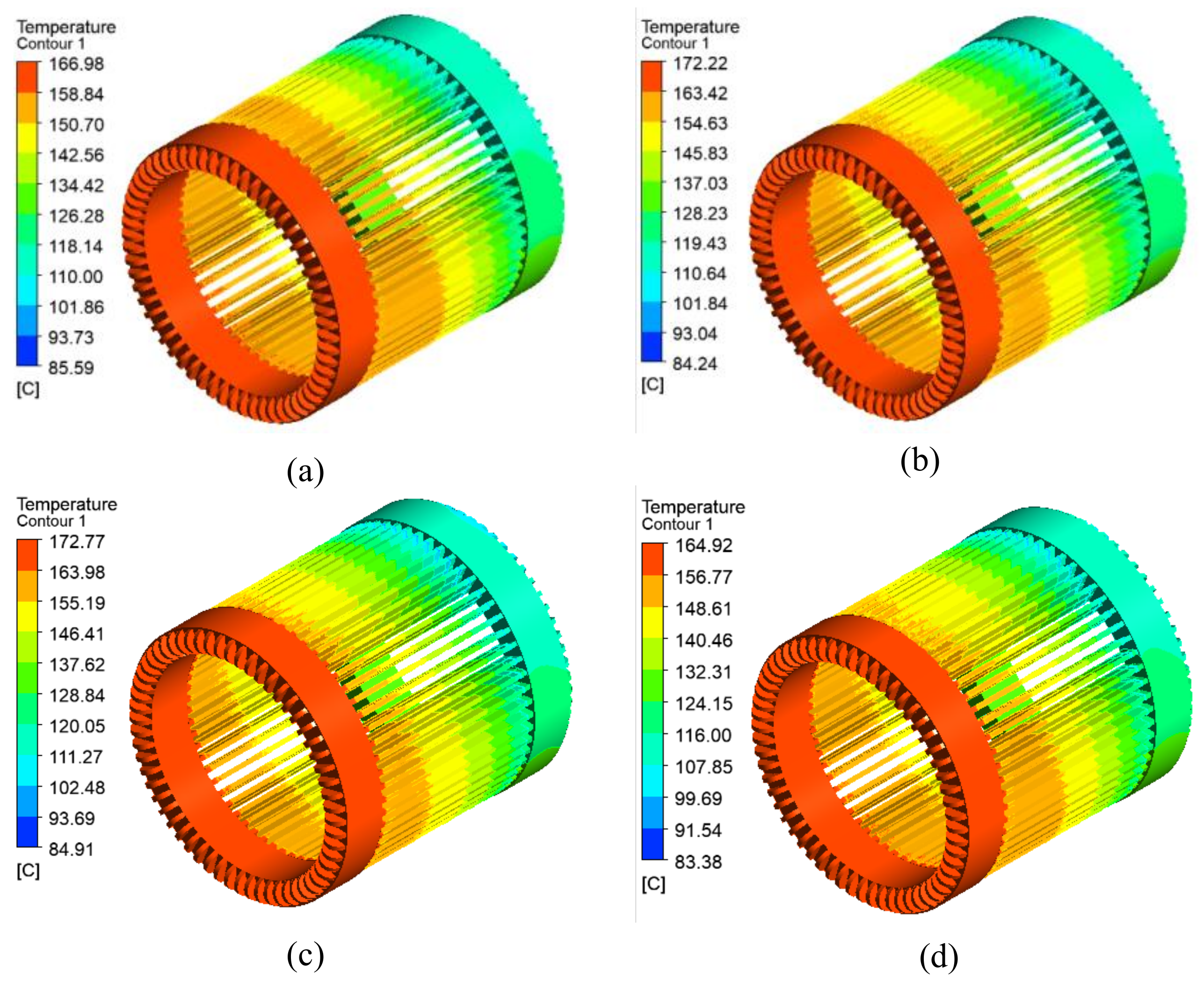

| Parameter | Value |
|---|---|
| Rated Power | 600 (kW) |
| Rated Voltage | 2730 (V) |
| Rated Current | 155 (A) |
| Current Density | 5.47 (A/mm2) |
| Frequency | 155.55 (Hz) |
| Speed | 4636 (r/min) |
| Efficiency | 94% |
| Power Factor | 0.87 |
| Stator Core Length | 270 (mm) |
| Stator Outer Diameter | 555 (mm) |
| Stator Inner Diameter | 330 (mm) |
| Air gap length | 1.8 (mm) |
| Rotor Inner Diameter | 330 (mm) |
| Number of stator slots | 60 |
| Number of rotor slots | 48 |
| The radial position of the stator ventilation hole | 257.5 (mm) |
| Parameter | Value |
|---|---|
| Stator Winding | 5.814 (kW) |
| Stator Yoke | 5.285 (kW) |
| Stator Teeth | 2.667 (kW) |
| Rotor Bar | 3.900 (kW) |
| Rotor | 0.42 (kW) |
| Additional loss | 3.159 (kW) |
| Mechanical loss | 7.56 (kW) |
| Scheme | Cross-Sectional Diameter (mm) | Radial Position (mm) |
|---|---|---|
| 6 | 24-22-20-18-16 | 257.5 |
| 7 | 22-20-18-16-14 | 257.5 |
| 8 | 20-18-16-14-12 | 257.5 |
| Scheme | Cross-Sectional Diameter (mm) | Radial Position (mm) |
|---|---|---|
| 9 | 22-20-18-16-14 | 247.5 |
| 10 | 22-20-18-16-14 | 237.5 |
| 11 | 22-20-18-16-14 | 227.5 |
Publisher’s Note: MDPI stays neutral with regard to jurisdictional claims in published maps and institutional affiliations. |
© 2021 by the authors. Licensee MDPI, Basel, Switzerland. This article is an open access article distributed under the terms and conditions of the Creative Commons Attribution (CC BY) license (https://creativecommons.org/licenses/by/4.0/).
Share and Cite
Cao, J.; Yan, H.; Li, D.; Wang, Y.; Li, W. Influence of the Variable Cross-Section Stator Ventilation Structure on the Temperature of an Induction Motor. Energies 2021, 14, 5249. https://doi.org/10.3390/en14175249
Cao J, Yan H, Li D, Wang Y, Li W. Influence of the Variable Cross-Section Stator Ventilation Structure on the Temperature of an Induction Motor. Energies. 2021; 14(17):5249. https://doi.org/10.3390/en14175249
Chicago/Turabian StyleCao, Junci, Hua Yan, Dong Li, Yu Wang, and Weili Li. 2021. "Influence of the Variable Cross-Section Stator Ventilation Structure on the Temperature of an Induction Motor" Energies 14, no. 17: 5249. https://doi.org/10.3390/en14175249
APA StyleCao, J., Yan, H., Li, D., Wang, Y., & Li, W. (2021). Influence of the Variable Cross-Section Stator Ventilation Structure on the Temperature of an Induction Motor. Energies, 14(17), 5249. https://doi.org/10.3390/en14175249






